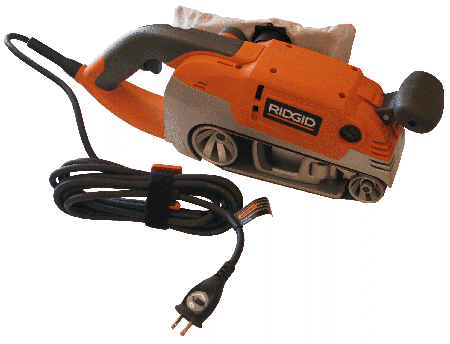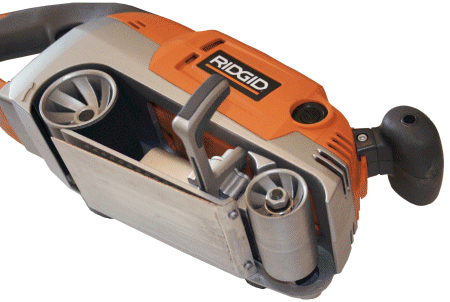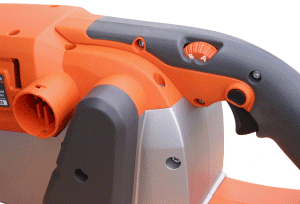|
|
|
| Description The Ridgid R2720 is a typical 3x21 belt sander with an in-line motor. It has a sort of 80's styling with it's swept cast aluminum mag wheels. Although belt sanders are fairly simple machines and most often associated with rougher more basic work; they are capable of fine work also. More correctly, a well made machine is capable of such work. Belt sanders are good for sanding stock to remove machine marks and other surface defects as well as some contour and what I'll cal "fix-it" sanding. These are situations where two or more surfaces need to be evened out or where a tapered or other irregular surface needs to be made. A quality machine will handle both these course and fine work tasks easily. |
 |
| The Ridgid R2720 has a powerful 10 amp motor with soft-start. The soft-start isn't going to win any belt-sander races but it is a nice to have in woodworking. It also comes with a nice loooong 12 foot power cord with a built in light to indicate the circuit is live and (a first on any OEM power tool I've used) a cord wrap to keep the thing under control. The inline handle has a rubber over-mold which provides for a good grip. The variable speed knob is within easy thumb reach on the handle. A repositionable (using a tool) pommel handle on the front of the machine also has a rubber over-mold. The belt tracking adjustment and belt tension release are both easy to operate. A fabric dust collection bag locks onto the left hand side and is fairly compact keeping the tool maneuverable. | |
|
There are basically two grades of belt sanders. There are budget sanders and there are more expensive high end models. A budget sander can be significantly cheaper than a higher end model like the Ridgid but since the machines look so similar it is not an unnatural question to wonder why one should pay more for the costlier model - after all, both will sand things flat. In a word, quality. This will directly translate into control and ease of use - why is that important? |
| In my opinion, belt sanders which do not have good balance and ease of use (that would be the cheap ones) are responsible for creating more problems for woodworkers than they ever solve. Without good feedback, balance and control - it is all too easy to over-sand, gouge, or otherwise create a "solution" far worse than the original problem. | |
| In Use One of the first things I noticed when I picked the sander up is that the tool is extremely well balanced. This is not because it is some featherweight with no meat to back itself up, the tool is adequately hefty (at 10.5lbs) to work on it's own weight alone. This balanced feel does not diminish when the tool is in use either. The 3x21 format is large enough to be used for standard stock preparation and small enough for more detailed work situations. With the handle in place, it can sand up to 4.1" from a wall on the front side. With the handle taken off, this distance reduces to 2.4". |
 |
| On the left side of the tool, it can sand up to 1.4" from a wall. The right side of the tool has no limitations and can sand right up to the edge. The 1.5" diameter front wheel is sufficiently small to allow some pretty small contour sanding. The balance of the tool supports this use also. | |
 |
Ridgid uses a typical cork backed
steel platen which I found to be flat. These are wear items though, the cork will compress
before the steel wears but this would be replaced as an assembly. When this item wears,
many belt sander owners switch to a graphite cloth pad. The Ridgid would be compatible
with this as its platen is held on with easy to access screws. Although the Ridgid does have a dust collection bag I did notice a lot of dust exhausted from the fan ports on the right of the tool so it is obviously not all traveling towards the collection bag. I eventually made a vac-hose adapter for it out of the bag coupling and a 1" pvc elbow fitting. |
| Summary A well made belt sander is one of unsung hero's of woodworking. You just use it for a bit then put it away. It doesn't create dentil moulding, Roman Ogee edges, spiral fluted columns, dovetails, or raised panel doors; other tools garner all the glory. What it does do though is help create those items by preparing the stock and reducing the sanding effort that would be needed later. It also flattens otherwise uneven surfaces giving the illusion of original perfection and is useful for rough trim work sick as scribing cabinets to walls etcetera. Although I wish it had better dust collection, the Ridgid R2720 excels in every other aspect one needs a belt sander to be proficient in. I found the Ridgid to be an exceptionally well balanced and smooth running tool. I really like the powerful variable speed motor.
In the interest of full disclosure Ridgid provided this product to facilitate this review.
|